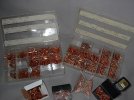judgebill
Well-Known Member
Reloading any cartridge, when you finish seating the bullet and measure successive fully-loaded cartridges, the measurements should be identical. That is, the distance between the shell holder and the bullet seating die are a constant. So regardless of variations in cartridge case length and carrying bullet lengths, the overall length, Cartridge Base to Orgive should be constant. This assumes no "stretch" or play in the loading machinery. I notice this in all different calibers. What am I missing"



